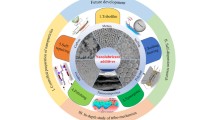Abstract
Functional surfaces can be made to produce various effects by modifying the surfaces of materials. To make functional surfaces for various industrial fields various methods have been used to modify and control the wettability of the surface. In this study, we focused on treating the wettability of a liquid film surface by applying vertical high-frequency vibration. Especially, the relationship between the vibration and the coating film thickness was carefully investigated, to ensure the maximum roughness control in thin liquid films. For surface roughness analysis, three methods were used. First, we measured the contact angle using high speed camera. In results, as frequency increases, contact angle decreases while as voltage increases, contact angle increases. Second, we measured surface roughness using displacement sensor. As a result, both surface wavelength and amplitude decreased as frequency increased. Third, we analyzed the surface shapes of the samples produced with differing viscosity, frequency, and voltage of the applied vibration. As a result, as frequency increases, or viscosity or voltage decrease, the change in the surface shape decreases. It means the surface roughness is decreased. We found that it was necessary to optimize the liquid film thickness in consideration of the damping effect or viscous penetration length when performing surface treatment using vibration. These findings confirm that it is necessary to optimize the process by taking into account the vibration, viscosity and film thickness for proper film surface treatment, and that surface treatment using the vibration method can be productively used in various industrial fields.











Similar content being viewed by others
References
Atae-Allah C, Cabrerizo-Vílchez M, Gómez-Lopera JF, Holgado-Terriza JA, Román-Roldán R, Luque-Escamilla PL (2001) Measurement of surface tension and contact angle using entropic edge detection. Meas Sci Technol 12(3):288
Cabrera JN, Ruiz MM, Fascio M, D’Accorso N, Mincheva R, Dubois P, Negri RM (2017) Increased surface roughness in polydimethylsiloxane films by physical and chemical methods. Polymers 9(8):331
De Gennes PG, Brochard-Wyart F, Quéré D (2013) Capillarity and wetting phenomena: drops, bubbles, pearls, waves. Springer Science & Business Media, New York
Eslamian M (2017) Excitation by acoustic vibration as an effective tool for improving the characteristics of the solution-processed coatings and thin films. Prog Org Coat 113:60–73
Gholampour N, Brian D, Eslamian M (2018) Tailoring characteristics of PEDOT: PSS coated on glass and plastics by ultrasonic substrate vibration post treatment. Coatings 8(10):337
Hwang J, Shoji N, Endo A, Daiguji H (2014) Effect of withdrawal speed on film thickness and hexagonal pore-array dimensions of SBA-15 mesoporous silica thin film. Langmuir 30(51):15550–15559
Ionov L, Houbenov N, Sidorenko A, Stamm M, Minko S (2006) Smart microfluidic channels. Adv Funct Mater 16(9):1153–1160
Lee JB, Gwon HR, Lee SH, Cho M (2010) Wetting transition characteristics on microstructured hydrophobic surfaces. Mater Trans 51(9):1709
Luo J, Fu YQ, Milne W (2013) Acoustic wave based microfluidic and lab-on-chip. In: Beghi M (ed) Modeling and Measurement Methods for Acoustic Waves and for Acoustic Microdevices, InTech, Rijeka, pp 515–556. https://doi.org/10.5772/2581
Nikolaevich Livanskiy A, Mikhailovich Prikhodko V, Konstantinovich Sundukov S, Sergeevich Fatyukhin D (2016) Research on the influence of ultrasonic vibrations on paint coating properties. Trans FAMENA 40(1):129–138
Nouri A, Wen C (2015) Introduction to surface coating and modification for metallic biomaterials. In: Surface coating and modification of metallic biomaterials. Woodhead Publishing, pp 3–60
Park JG, Pas MF (1995) Effects of drying methods and wettability of silicon on the formation of water marks in semiconductor processing. J Electrochem Soc 142(6):2028
Rahimzadeh A, Eslamian M (2017) Stability of thin liquid films subjected to ultrasonic vibration and characteristics of the resulting thin solid films. Chem Eng Sci 158:587–598
Rahimzadeh A, Ahmadian-Yazdi MR, Eslamian M (2018) Experimental study on the characteristics of capillary surface waves on a liquid film on an ultrasonically vibrated substrate. Fluid Dyn Res 50(6):065510
Rezk AR, Manor O, Friend JR, Yeo LY (2012) Unique fingering instabilities and soliton-like wave propagation in thin acoustowetting films. Nat Commun 3(1):1–7
Sberveglieri G (1995) Recent developments in semiconducting thin-film gas sensors. Sens Actuators B Chem 23(2–3):103–109
Schneider M (2011) Wettability patterning in microfluidic systems and applications in the petroleum industry (Doctoral dissertation, Université Pierre et Marie Curie-Paris VI)
Wan Q, Li QH, Chen YJ, Wang TH, He XL, Li JP, Lin CL (2004) Fabrication and ethanol sensing characteristics of ZnO nanowire gas sensors. Appl Phys Lett 84(18):3654–3656
Wen H, Guo J, Li Y, Liu Y, Zhang K (2018) The transmissibility of a vibration isolation system with ball-screw inerter based on complex mass. J Low Freq Noise Vib Active Control 37(4):1097–1108
Yamazoe N (1991) New approaches for improving semiconductor gas sensors. Sens Actuators B Chem 5(1–4):7–19
Acknowledgements
This work was supported by the National Research Foundation of Korea (NRF) Grant funded by the Korea government (MSIT) (2018R1A2B6006891). This study was conducted with the support of the Ministry of Trade, Industry and Energy (MOTIE) and the Korea Energy Technology Evaluation Institute (KETEP) (no. 20194030202440). This work was supported by the Gachon University research fund of 2020 (GCU-202004400001). The English in this document has been checked by at least two professional editors, both native speakers of English. For a certificate, please see: https://www.textcheck.com/certificate/IsA7kp.
Author information
Authors and Affiliations
Corresponding author
Additional information
Publisher's Note
Springer Nature remains neutral with regard to jurisdictional claims in published maps and institutional affiliations.
Rights and permissions
About this article
Cite this article
Park, DS., Park, KS. Vibration-based surface treatment considering viscous penetration length. Microsyst Technol 27, 2269–2279 (2021). https://doi.org/10.1007/s00542-020-05099-8
Received:
Accepted:
Published:
Issue Date:
DOI: https://doi.org/10.1007/s00542-020-05099-8




